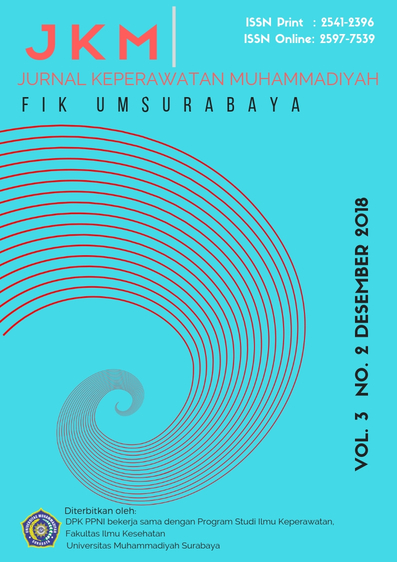Peranan Pencucian Luka Terhadap Penurunan Kolonisasi Bakteri Pada Luka Kaki Diabetes
DOI:
https://doi.org/10.30651/jkm.v3i2.1829Keywords:
Bacterial Colonization, Diabetic Ulcers, Wound cleansing.Abstract
ABSTRACT
Background: Diabetic ulcer is a major complication of diabetes and is the main cause of infection. One of the efforts or interventions to reduce infection by doing wound cleansing, but research on the effects of wound cleansing on bacterial colonization is still limited. The purpose of this literature study was to determine the effectiveness of using a type of wound cleansing on changes in bacterial colonization in DM wounds.
Methods: The data base used in making this review literature is Pubmed, Science Direct, Google Scholar and Cochrane. there are 144 articles identified and published from 2010-2018. Of the 144 articles 8 articles that met the inclusion criteria.
Results: Various wound cleansing solutions are used to optimize the wound healing process and the effect is quite good in decreasing bacterial colonies in DM wounds. Conclusion: wound cleansing type ESWA has a bactericidal effect, is effective in reducing bacterial colonization, and economically it is expected to be a concern in the treatment process injury, research is needed as to whether ESWA washing types can be used to reduce bacterial colonization in DM wounds.
References
DAFTAR PUSTAKA
Akbar, A., Morteza, S., Jafari, S., Kiasat, M., Reza, M., & Ahrari, I. (2013). Efficacy of debridement and wound cleansing with 2 % hydrogen peroxide on graft take in the chronic-colonized burn wounds ; a randomized controlled clinical trial. Burns, 39(6), 1131–1136. https://doi.org/10.1016/j.burns.2013.01.019
Alexiadou, K., & Doupis, J. (2012). Management of diabetic foot ulcers. Diabetes Therapy, 3(1), 1–15. https://doi.org/10.1007/s13300-012-0004-9
Arisanty, I. P. (2013). Konsep Dasar ; MANAJEMEN PERAWATAN LUKA. (P. E. Karyuni, Ed.). Jakarta: EGC.
Arjunan, S. P., Tint, A. N., Aliahmad, B., Kumar, D. K., Shukla, R., Miller, J., … Ekinci, E. I. (2018). High-Resolution Spectral Analysis Accurately Identifies the Bacterial Signature in Infected Chronic Foot Ulcers in People With Diabetes. https://doi.org/10.1177/1534734618785844
Arya, A. K., Tripathi, R., Kumar, S., & Tripathi, K. (2014). Recent advances on the association of apoptosis in chronic non healing diabetic wound, 5(6), 756–762. https://doi.org/10.4239/wjd.v5.i6.756
Bellingeri, A., Falciani, F., Traspedini, P., Moscatelli, A., Russo, A., Tino, G., … Peghetti, A. (2016). Effect of a wound cleansing solution on wound bed preparation and inflammation in chronic wounds: a single-blind RCT. Journal of Wound Care, 25(3), 160–168. https://doi.org/10.12968/jowc.2016.25.3.160
Bongiovanni, C. M. (2014). Effects of Hypochlorous Acid Solutions on Venous Leg Ulcers (VLU): Experience With 1249 VLUs in 897 Patients. Journal of the American College of Clinical Wound Specialists, 6(3), 32–37. https://doi.org/10.1016/j.jccw.2016.01.001
Cervantes-GarcÃa, E., & Salazar-Schettino, P. M. (2017). Clinical and surgical characteristics of infected diabetic foot ulcers in a tertiary hospital of Mexico. Diabetic Foot and Ankle, 8(1). https://doi.org/10.1080/2000625X.2017.1367210
Chen, X., Li, P., Wang, X., Gu, M., Zhao, C., Sloan, A. J., … Yu, Q. (2013). Ex vivo antimicrobial efficacy of strong acid electrolytic water against Enterococcus faecalis biofilm. International Endodontic Journal, 46, 938–946. https://doi.org/10.1111/iej.12084
Cheng, X., Tian, Y., Zhao, C., Qu, T., Ma, C., Liu, X., & Yu, Q. (2016). Bactericidal effect of strong acid electrolyzed water against flow enterococcus faecalis biofilms. Journal of Endodontics, 42(7), 1120–1125. https://doi.org/10.1016/j.joen.2016.04.009
Guo, S., & DiPietro, L. A. (2010). Critical review in oral biology & medicine: Factors affecting wound healing. Journal of Dental Research, 89(3), 219–229. https://doi.org/10.1177/0022034509359125
Hao, J., Li, H., Wan, Y., & Liu, H. (2015). Combined effect of acidic electrolyzed water (AcEW) and alkaline electrolyzed water (AlEW) on the microbial reduction of fresh-cut cilantro. Food Control, 50, 699–704. https://doi.org/10.1016/j.foodcont.2014.09.027
Klasinc, R., Augustin, L. A., Below, H., Baguhl, R., Assadian, O., Presterl, E., & Kramer, A. (2017). Evaluation of three experimental in vitro models for the assessment of the mechanical cleansing efficacy of wound irrigation solutions, 1–8. https://doi.org/10.1111/iwj.12850
Kubota, A., Goda, T., Tsuru, T., Yonekura, T., Yagi, M., Kawahara, H., … Hirano, K. (2015). Efficacy and safety of strong acid electrolyzed water for peritoneal lavage to prevent surgical site infection in patients with perforated appendicitis. Surgery Today, 45(7), 876–879. https://doi.org/10.1007/s00595-014-1050-x
Kubota, A., Nose, K., Yonekura, T., Kosumi, T., Yamauchi, K., & Oyanagi, H. (2009). Effect of electrolyzed strong acid water on peritoneal irrigation of experimental perforated peritonitis. Surgery Today, 39(6), 514–517. https://doi.org/10.1007/s00595-008-3914-4
Kurnia, S., Sumangkut, R., & Hatibie, M. (2017). Perbandingan kepekaan pola kuman ulkus diabetik terhadap pemakaian PHMB gel dan NaCl gel secara klinis. Jurnal Biomedik, 9(1), 38–44. Retrieved from https://ejournal.unsrat.ac.id/index.php/biomedik/article/view/15318
Lopes, L., Setia, O., Aurshina, A., Liu, S., Hu, H., Isaji, T., … Dardik, A. (2018). Stem cell therapy for diabetic foot ulcers : a review of preclinical and clinical research, 1–16.
Mansur, A. R., Nku, C., Kim, G., & Oh, D. (2015). Combined effects of slightly acidic electrolyzed water and fumaric acid on the reduction of foodborne pathogens and shelf life extension of fresh pork, 47, 277–284. https://doi.org/10.1016/j.foodcont.2014.07.019
Queirós, P., Santos, E., Apóstolo, J., Cardoso, D., Cunha, M., & Rodrigues, M. (2014). The effectiveness of cleansing solutions for wound treatment: a systematic review. JBI Database of Systematic Reviews and Implementation Reports, 12(10), 121–151. https://doi.org/10.11124/jbisrir-2014-1746
Shiratori, T., Sowa-Osako, J., Fukai, K., & Tsuruta, D. (2017). Severe stomatitis with a deep buccal ulcer associated with an allergic reaction to methyl methacrylate used for dental treatment. Contact Dermatitis, 77(6), 406–407. https://doi.org/10.1111/cod.12742
Wattanaploy, S., Chinaroonchai, K., Namviriyachote, N., & Muangman, P. (2017). Randomized Controlled Trial of Polyhexanide / Betaine Gel Versus Silver Sulfadiazine for Partial-Thickness Burn Treatment. https://doi.org/10.1177/1534734617690949
Wilkins, R. G., & Unverdorben, M. (2013). Wound cleaning and wound healing: a concise review. Advances in Skin & Wound Care, 26(4), 160–3. https://doi.org/10.1097/01.ASW.0000428861.26671.41
Wolcott, R. D., & Fletcher, J. (2014). Technology update: Role of wound cleansing in the management of wounds. Wounds UK, 10(2), 58–63.
Downloads
Published
Issue
Section
License
- Penulis tetap memegang hak atas karyanya dan memberikan hak publikasi pertama kepada jurnal ini yang secara simultan karya tersebut dilisensikan di bawah:Â Creative Commons Attribution-ShareAlike 4.0 International (CC BY-SA 4.0)













